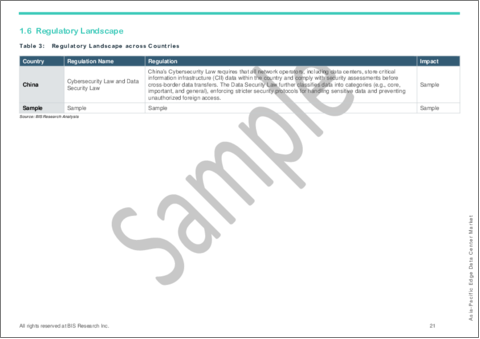|
|
市場調査レポート
商品コード
1735902
アジア太平洋のエッジデータセンター市場:製品別、用途別、国別 - 分析と予測(2025年~2034年)Asia-Pacific Edge Data Center Market: Focus on Product, Application, and Country Analysis - Analysis and Forecast, 2025-2034 |
||||||
カスタマイズ可能
|
|||||||
| アジア太平洋のエッジデータセンター市場:製品別、用途別、国別 - 分析と予測(2025年~2034年) |
|
出版日: 2025年05月30日
発行: BIS Research
ページ情報: 英文 54 Pages
納期: 1~5営業日
|
全表示
- 概要
- 図表
- 目次
アジア太平洋のエッジデータセンターの市場規模は、2024年に66億4,090万米ドルとなりました。
同市場は、2034年には364億4,840万米ドルに達し、予測期間の2025年~2034年のCAGRは17.99%と堅調に推移すると予測されています。特に5Gネットワーク、IoT展開、スマートシティプロジェクトが地域全体に広がるにつれて、低レイテンシー、分散コンピューティングアーキテクチャへの傾向が強まっており、アジア太平洋のエッジデータセンター市場を後押ししています。エッジサイトは、コンピューティングとストレージ機能をエンドポイントの近くに配置することで、自律走行車、リアルタイムビデオ分析、AR/VRアプリ、産業オートメーションなどのデータ集約的なユースケースにミリ秒レベルの応答時間を提供し、集中型クラウドとコアネットワークの負担を軽減します。
中国の「新インフラ」プログラムや韓国の5G+戦略から、インドの国家デジタル通信政策やシンガポールのスマート・ネーション・ビジョンに至るまで、エッジ構築は政府やサービス・プロバイダーにとって最重要課題となっています。事業者の設備投資と運用コストは、マイクロデータセンターの設置に対する補助金、民間の5Gネットワークに対する周波数割り当て、ローカルビルド施設に対する有利な税制優遇措置によって賄われています。地理的に分散したコンピュート・ノードの要件は、日本の産業における予知保全からオーストラリアの精密農業まで、使用事例が爆発的に拡大していることでさらに浮き彫りになっています。
| 主要市場統計 | |
|---|---|
| 予測期間 | 2025年~2034年 |
| 2025年の評価 | 82億2,460万米ドル |
| 2034年予測 | 364億4,840万米ドル |
| CAGR | 17.99% |
ハードウェアの設置面積の標準化、遠隔地の物理的セキュリティの維持、マルチベンダーの相互運用性の確保といった問題は依然として存在するもの、モジュール式のプレハブエッジポッドや高度な冷却ソリューションの継続的な研究開発により、開発リスクは徐々に低下しています。この地域の次世代デジタル経済は、通信事業者やアジア太平洋の企業が商用展開やテストプログラムを拡大するにつれて、エッジデータセンターに大きく依存するようになると思われます。
アジア太平洋のエッジデータセンター市場は、同地域の政府機関や企業がローカライズされたデータ処理、超低レイテンシーコンピューティング、ネットワーク耐障害性の向上を求める中、急速に拡大しています。ネットワークのエッジで時間に敏感なワークロードを管理することで、エッジデータセンター(エンドユーザーやIoTノードの近くに位置する小さな建物)は、従来のハイパースケールクラウドを補完します。ドライバーレス・カー、スマートシティ・サービス、拡張現実やバーチャル・リアリティ、産業オートメーションなど、リアルタイムの分析が必要な用途では、このローカライズされた方法により、往復の待ち時間が短縮され、コアネットワークの帯域幅の制限が緩和され、サービス品質が向上します。
エッジの導入は、多くの地域的な取り組みによって加速しています。韓国の「5G+戦略」が通信事業者や企業に次世代モバイルサービス用のエッジノードの設置を奨励する一方で、中国の「新インフラ」構想は5G基地局とマイクロデータセンターに向けて数十億米ドルの投資を割り当てています。インドの国家デジタル通信政策では、分散したコンピュート・サイトに支えられた堅牢で大容量の接続ネットワークが目標とされており、シンガポールのスマート・ネーション枠組みでは、交通、ヘルスケア、監視などのエッジ対応ユースケースを特に優先しています。これらのルールに加え、特定の税制優遇措置、民間の5Gネットワーク向けの周波数割り当て、譲許的な融資が、極小データセンターの導入を促進する環境を作り出しています。
商業的需要も同様に強いです。オーストラリアや日本の巨大製造業が予知保全や工場自動化のワークロードをエッジに導入する一方で、eコマースのリーダーやデジタルゲームプラットフォームは、リアルタイムのパーソナライズやマルチプレーヤーの同期など、レイテンシーの影響を受けやすいサービスをエッジサイトに移行しています。通信事業者は、Software-Definedインフラ、コンテナ化されたマイクロサービス、AI主導のオーケストレーション・ツールといったエコシステムの拡大を活用し、エッジ・アズ・ア・サービスとコアネットワークの強化を組み合わせています。
この勢いにもかかわらず、まだ困難があります。マルチベンダーのエッジスタック間の相互運用性は一貫しておらず、標準化の取り組みはまだ初期段階にあり、サイバーや物理的な脅威からリモートサイトを保護するには新しいプロトコルが必要です。さらに、資本コストと運用コストを削減するためには、モジュール構築ソリューションと効果的な冷却が不可欠です。しかし、エネルギー効率に優れた設計、統合管理プラットフォーム、プレハブ式エッジポッドなどの継続的な研究開発により、導入リスクは徐々に軽減されつつあります。
全体として、アジア太平洋のエッジデータセンター市場は、企業や公共機関がこれまでにないスピードと信頼性でインテリジェントでミッションクリティカルなサービスを提供できるようにすることで、この地域のデジタル変革の要となる態勢を整えています。
市場セグメンテーション
セグメンテーション1:エンドユーザー業界別
- ITおよび電気通信
- 銀行、金融サービス、保険(BFSI)
- 政府・公共部門
- ヘルスケア
- 製造業
- 自動車
- 小売業
- その他
セグメンテーション2:タイプ別
- オンプレミスエッジ
- ネットワークエッジ
- 地域エッジ
セグメンテーション3:国別
- 日本
- 中国
- オーストラリア
- その他
アジア太平洋のエッジデータセンターの市場動向と促進要因・課題
動向
- セルサイトや都市ハブにおける5G対応マイクロデータセンターの普及
- モジュール式のプレハブ「エッジポッド」設計による迅速な展開
- ネットワークエッジにおけるAI/MLおよびリアルタイム分析ワークロードの成長
- 通信事業者やクラウドプロバイダー別エッジ・アズ・ア・サービスの登場
- エンタープライズIoT向けのプライベート5GおよびLoRaWANネットワークとの統合
- エネルギー効率の高いアーキテクチャと液冷ソリューションへの注力
促進要因
- 中国、インド、韓国、東南アジアでの大規模な5G展開
- スマートシティ、製造業、小売業における爆発的なIoTデバイスの増加
- 超低レイテンシーの需要(AR/VR、自律走行車)
- 政府プログラム(中国の新インフラ、インドのNDCPなど)
- 企業のデジタル変革および持続可能性の義務
- 譲許的融資、補助金、税制優遇措置の利用可能性
課題
- 標準化されたハードウェアフットプリントとソフトウェアスタックの欠如
- マルチベンダーの相互運用性と統一オーケストレーションのハードル
- サイバー物理的脅威に対する分散型サイトの安全性
- 都市部における電力密度、冷却、不動産の制約
- 高額な初期投資と断片的な規制環境
- エッジに特化した展開と運用のためのスキル不足
実践/イノベーション戦略:アジア太平洋のエッジデータセンター市場のセグメンテーションにより、エッジコンピューティングで使用される技術、インフラタイプ、展開戦略を包括的に理解することができます。オンプレミスエッジ、ネットワークエッジ、地域エッジデータセンターなどの主なコンポーネントにハイライトを当て、これらのソリューションがいかにデータ処理効率を高め、待ち時間を短縮し、リアルタイムコンピューティングをサポートするかを紹介しています。さらに、モジュール式インフラ、エネルギー効率の高い冷却ソリューション、AIを活用したネットワーク最適化など、現在のエッジデータセンターの導入状況を詳細に分析しています。この洞察は、企業や利害関係者がエッジコンピューティングの進化と、スケーラブルで安全かつ高性能なデジタルエコシステムの構築におけるその役割を理解するのに役立ちます。
成長/マーケティング戦略:アジア太平洋のエッジデータセンター市場では、事業拡大、提携、協業、合弁など、市場参入企業による主要な開拓が見られます。各社の戦略は、アジア太平洋のエッジデータセンター市場での地位を強化するためのパートナーシップ、コラボレーション、ジョイントベンチャー活動です。
競合戦略:本調査で分析・プロファイルしたアジア太平洋のエッジデータセンター市場の主要企業には、プロジェクト開拓者や会計ツールプロバイダーなどが含まれます。分析では、用途別市場セグメント、タイプ別製品、地域プレゼンス、主要市場戦略の影響などを取り上げています。さらに、詳細な競合ベンチマーキングを実施し、競合各社の比較や市場情勢を明らかにしています。また、アジア太平洋のエッジデータセンター市場における未開拓の収益機会を特定するために、パートナーシップ、契約、提携などの包括的な競合戦略についても検証しています。
当レポートでは、アジア太平洋のエッジデータセンター市場について調査し、市場の概要とともに、製品別、用途別、国別の動向、および市場に参入する企業のプロファイルなどを提供しています。
目次
エグゼクティブサマリー
第1章 市場
- 動向:現状と将来への影響評価
- エッジデータセンター市場を形成する動向
- 5Gネットワークの展開
- モノのインターネット(IoT)デバイスの普及
- ソフトウェア定義ネットワーク(SDN)技術の採用
- サプライチェーンの概要
- 研究開発レビュー
- 技術分析
- 投資家、事業者、企業への影響
- 規制状況
- 市場力学の概要
第2章 地域
- 地域のサマリー
- アジア太平洋
- アジア太平洋の主要市場参入企業
- 地域概要
- 市場成長促進要因
- 市場成長抑制要因
- 用途
- 製品
- 中国
- 日本
- オーストラリア
- その他
第3章 市場-競合ベンチマーキングと企業プロファイル
- 競合情勢
- 企業プロファイル
- 最先端のデータセンター
第4章 調査手法
List of Figures
- Figure 1: Asia-Pacific Edge Data Center Market (by End-Use Industry), $Million, 2024, 2027, and 2034
- Figure 2: Asia-Pacific Edge Data Center Market (by Type), $Million, 2024, 2027, and 2034
- Figure 3: Population Coverage by Technology, 2023 and 2029
- Figure 4: Supply Chain Analysis for Edge Data Center Market
- Figure 5: Patent Filed (by Country), January 2020-December 2023
- Figure 6: Patent Filed (by Company), January 2020-December 2023
- Figure 7: Impact Analysis of Edge Data Center Market Navigating Factors, 2023-2033
- Figure 8: AI Publications (% of Total) by Sector and Geographic Area, 2021
- Figure 9: Data Generated Annually (Estimated), 2010-2025
- Figure 10: China Edge Data Center Market, $Million, 2023-2034
- Figure 11: Japan Edge Data Center Market, $Million, 2023-2034
- Figure 12: Australia Edge Data Center Market, $Million, 2023-2034
- Figure 13: Rest-of-Asia-Pacific Edge Data Center Market, $Million, 2023-2034
- Figure 14: Strategic Initiatives, 2023
- Figure 15: Share of Strategic Initiatives, 2023
- Figure 16: Data Triangulation
- Figure 17: Top-Down and Bottom-Up Approach
- Figure 18: Assumptions and Limitations
List of Tables
- Table 1: Market Snapshot
- Table 2: Edge Data Center Market, Opportunities across Regions
- Table 3: Regulatory Landscape across Countries
- Table 4: Edge Data Center Market (by Region), $Million, 2023-2034
- Table 5: Asia-Pacific Edge Data Center Market (by End-Use Industry), $Million, 2024-2034
- Table 6: Asia-Pacific Edge Data Center Market (by Type), $Million, 2023-2034
- Table 7: China Edge Data Center Market (by End-Use Industry), $Million, 2024-2034
- Table 8: China Edge Data Center Market (by Type), $Million, 2023-2034
- Table 9: Japan Edge Data Center Market (by End-Use Industry), $Million, 2024-2034
- Table 10: Japan Edge Data Center Market (by Type), $Million, 2023-2034
- Table 11: Australia Edge Data Center Market (by End-Use Industry), $Million, 2024-2034
- Table 12: Australia Edge Data Center Market (by Type), $Million, 2023-2034
- Table 13: Rest-of-Asia-Pacific Edge Data Center Market (by End-Use Industry), $Million, 2024-2034
- Table 14: Rest-of-Asia-Pacific Edge Data Center Market (by Type), $Million, 2023-2034
- Table 15: Market Share, 2023
Introduction to Asia-Pacific Edge Data Center Market
The Asia-Pacific edge data center market, valued at $6,640.9 million in 2024, is expected to reach $36,448.4 million by 2034, exhibiting a robust CAGR of 17.99% during the forecast period 2025-2034. An increasing trend towards low-latency, distributed computing architectures is propelling the APAC edge data-center market, especially as 5G networks, IoT deployments, and smart-city projects spread throughout the region. Edge sites provide millisecond-level response times for data-intensive use cases like autonomous cars, real-time video analytics, AR/VR apps, and industrial automation by relocating compute and storage capabilities closer to endpoints, relieving strain on centralised clouds and core networks.
Edge build-outs are becoming a top focus for governments and service providers, from China's ""New Infrastructure"" program and South Korea's 5G+ Strategy to India's National Digital Communications Policy and Singapore's Smart Nation vision. Capex and opex for operators are being defrayed by subsidies for micro-data-center installations, spectrum allocations for private 5G networks, and advantageous tax treatment for local-build facilities. The requirement for geographically dispersed compute nodes is further highlighted by the use cases' explosive expansion, which ranges from predictive maintenance in Japanese industry to precision agriculture in Australia.
| KEY MARKET STATISTICS | |
|---|---|
| Forecast Period | 2025 - 2034 |
| 2025 Evaluation | $8,224.6 Million |
| 2034 Forecast | $36,448.4 Million |
| CAGR | 17.99% |
Deployment risk is progressively declining due to continuous research and development in modular, prefabricated edge pods and sophisticated cooling solutions, even though issues with standardising hardware footprints, maintaining physical security at remote sites, and insuring multi-vendor interoperability still exist. The region's next-generation digital economy will rely heavily on edge data centres as telcos and APAC businesses expand their commercial roll-outs and test programs.
Market Introduction
The market for edge data centres in Asia-Pacific (APAC) is growing quickly as governments and companies in the area seek for localised data processing, ultra-low latency computing, and improved network resilience. By managing time-sensitive workloads at the network's edge, edge data centers-small buildings situated near end users and IoT nodes-complement conventional hyperscale clouds. For applications needing real-time analytics, such as driverless cars, smart-city services, augmented and virtual reality, and industrial automation, this localised method lowers round-trip latency, eases bandwidth limitations on core networks, and enhances service quality.
Edge adoption is being accelerated by a number of regional efforts. While South Korea's 5G+ Strategy encourages carriers and businesses to install edge nodes for next-generation mobile services, China's ""New Infrastructure"" initiative allocates billions of dollars in investment towards 5G base stations and micro-data centres. A robust, high-capacity connection network supported by dispersed compute sites is the goal of India's National Digital Communications Policy, while Singapore's Smart Nation framework specifically gives priority to edge-enabled use cases in transportation, healthcare, and surveillance. These rules, along with specific tax incentives, spectrum allocation for private 5G networks, and concessional financing, have created an environment that is conducive to the implementation of tiny data centres.
Commercial demand is equally strong. While manufacturing behemoths in Australia and Japan embrace predictive maintenance and factory-automation workloads at the edge, e-commerce leaders and digital gaming platforms are shifting latency-sensitive services, like real-time personalisation and multi-player synchronisation, to edge sites. Telecom operators are taking advantage of the growing ecosystem of software-defined infrastructure, containerised micro-services, and AI-driven orchestration tools by combining edge-as-a-service offerings with core network enhancements.
There are still difficulties in spite of this momentum. Interoperability between multi-vendor edge stacks is inconsistent, standardisation efforts are still in their infancy, and new protocols are needed to protect remote sites from cyber and physical threats. Additionally, modular-build solutions and effective cooling are essential for reducing capital and operating costs. However, continuous research and development in energy-efficient designs, unified management platforms, and prefabricated edge pods is gradually reducing deployment risk.
Overall, the APAC edge data center market is poised to become a cornerstone of the region's digital transformation, enabling enterprises and public-sector bodies to deliver intelligent, mission-critical services with unprecedented speed and reliability.
Market Segmentation
Segmentation 1: by End-Use Industry
- IT and Telecom
- Banking, Financial Services, and Insurance (BFSI)
- Government and Public Sector
- Healthcare
- Manufacturing
- Automotive
- Retail
- Others
Segmentation 2: by Type
- On-Premise Edge
- Network Edge
- Regional Edge
Segmentation 3: by Country
- Japan
- China
- Australia
- Rest-of-Asia-Pacific
APAC Edge Data Center Market Trends, Drivers and Challenges
Trends
- Proliferation of 5G-enabled micro data centers at cell sites and urban hubs
- Modular, prefabricated "edge pod" designs for rapid deployment
- Growth of AI/ML and real-time analytics workloads at the network edge
- Emergence of edge-as-a-service offerings from telcos and cloud providers
- Integration with private 5G and LoRaWAN networks for enterprise IoT
- Focus on energy-efficient architectures and liquid-cooling solutions
Drivers
- Massive 5G rollouts across China, India, South Korea and Southeast Asia
- Explosive IoT device growth in smart cities, manufacturing and retail
- Demand for ultra-low-latency applications (AR/VR, autonomous vehicles)
- Government programs (e.g., China's New Infrastructure, India's NDCP)
- Corporate digital-transformation and sustainability mandates
- Availability of concessional financing, grants and tax incentives
Challenges
- Lack of standardized hardware footprints and software stacks
- Multi-vendor interoperability and unified orchestration hurdles
- Securing distributed sites against cyber-physical threats
- Power density, cooling and real-estate constraints in urban areas
- High initial capex and fragmented regulatory environments
- Skills shortages for edge-specific deployment and operations
How can this report add value to an organization?
Practice/Innovation Strategy: The segmentation of the APAC edge data center market provides a comprehensive understanding of the technologies, infrastructure types, and deployment strategies used in edge computing. It highlights key components such as on-premise edge, network edge, and regional edge data centers, showcasing how these solutions enhance data processing efficiency, reduce latency, and support real-time computing. Additionally, the study offers a detailed analysis of current edge data center deployments, highlighting innovations in modular infrastructure, energy-efficient cooling solutions, and AI-driven network optimization. This insight helps businesses and stakeholders understand the evolution of edge computing and its role in building scalable, secure, and high-performance digital ecosystems.
Growth/Marketing Strategy: The APAC edge data center market has seen major development by key participants operating in the market, such as business expansion, partnership, collaboration, and joint venture. The favored strategies of the companies have been partnership, collaboration, and joint venture activities to strengthen their position in the APAC edge data center market.
Competitive Strategy: Key players in the APAC edge data center market analyzed and profiled in the study include project developers and accounting tool providers. The analysis covers market segments by applications, products by type, regional presence, and the impact of key market strategies. Additionally, detailed competitive benchmarking has been conducted to illustrate how players compare, providing a clear view of the market landscape. The study also examines comprehensive competitive strategies, such as partnerships, agreements, and collaborations, to help identify untapped revenue opportunities in the APAC edge data center market.
Table of Contents
Executive Summary
Scope and Definition
1 Markets
- 1.1 Trends: Current and Future Impact Assessment
- 1.1.1 Trends Shaping Edge Data Center Market
- 1.1.2 5G Network Deployment
- 1.1.3 Proliferation of Internet of Things (IoT) Devices
- 1.1.4 Adoption of Software-Defined Networking (SDN) Technology
- 1.2 Supply Chain Overview
- 1.2.1 Value Chain Analysis
- 1.2.2 Market Map
- 1.2.2.1 Edge Data Center Market (by Type)
- 1.2.2.1.1 On-Premise Edge Providers
- 1.2.2.1.2 Network Edge Providers
- 1.2.2.1.3 Regional Edge Providers
- 1.2.2.1 Edge Data Center Market (by Type)
- 1.3 Research and Development Review
- 1.3.1 Patent Filing Trend (by Country and Company)
- 1.4 Technological Analysis
- 1.4.1 Current and Upcoming Technologies
- 1.4.2 Key Countries with the Highest Number of Edge Deployments
- 1.4.3 Technologies at Risk of Becoming Obsolete
- 1.5 Implications for Investors, Operators, and Enterprises
- 1.6 Regulatory Landscape
- 1.7 Market Dynamics Overview
- 1.7.1 Market Drivers
- 1.7.1.1 Minimizing Latency and Bandwidth Usage
- 1.7.1.1.1 Case Study: Comparing Edge Servers and Cloud Locations for Enhanced User Experience
- 1.7.1.2 Increasing Focus on Providing Personalized AI Services
- 1.7.1.1 Minimizing Latency and Bandwidth Usage
- 1.7.2 Market Restraints
- 1.7.2.1 Lack of Consideration of Security-by-Design
- 1.7.2.2 Non-Migratability of Security Frameworks
- 1.7.3 Market Opportunities
- 1.7.3.1 Surge in Investment by Data Center Providers
- 1.7.3.2 Increase in Data Generation
- 1.7.1 Market Drivers
2 Regions
- 2.1 Regional Summary
- 2.2 Asia-Pacific
- 2.2.1 Key Market Participants in Asia-Pacific
- 2.2.2 Regional Overview
- 2.2.3 Driving Factors for Market Growth
- 2.2.4 Factors Challenging the Market
- 2.2.5 Application
- 2.2.6 Product
- 2.2.7 China
- 2.2.8 Application
- 2.2.9 Product
- 2.2.10 Japan
- 2.2.11 Application
- 2.2.12 Product
- 2.2.13 Australia
- 2.2.14 Application
- 2.2.15 Product
- 2.2.16 Rest-of-Asia-Pacific
- 2.2.17 Application
- 2.2.18 Product
3 Markets - Competitive Benchmarking & Company Profiles
- 3.1 Competitive Landscape
- 3.2 Company Profile
- 3.2.1 Leading Edge Data Centres
- 3.2.1.1 Overview
- 3.2.1.2 Top Products/Product Portfolio
- 3.2.1.3 Top Competitors
- 3.2.1.4 Target Customers
- 3.2.1.5 Key Personnel
- 3.2.1.6 Analyst View
- 3.2.1.7 Market Share, 2023
- 3.2.1 Leading Edge Data Centres
4 Research Methodology
- 4.1 Data Sources
- 4.1.1 Primary Data Sources
- 4.1.2 Secondary Data Sources
- 4.1.3 Data Triangulation
- 4.2 Market Estimation and Forecast





